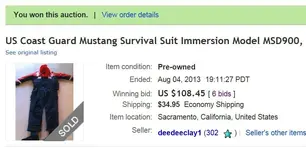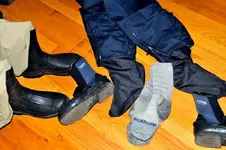Saturday morning I got to the beach early and it was raining all week and the water was very cool & green color and water visibility very poor, i was the only one in the water, big schools of small bait fish jumping outta the water, from watchin shark week I seen these conditions described as tell tale signs that are perfect for a shark attack. I seen a dolphin heading in front of me in deeper water, the dolphin popped up chewing on a fish right out in front of me about 50 feet, I figured if he was around probably ok but I still waited to go out chest deep until it warmed up and people started swimming. I've only seen a few sharks metal detecting, a couple bonnet heads @ ft. Desoto park and one I spooked that was bigger than me in shallow water in tampa bay @ Bahia beach in ruskin (not the gulf) in 2005, that made my heart skip a beat and have always been wary, don't know what kind it was cause it happened so fast just that it was a shark and not a dolphin. Sir Gala Clad what were the rules the rookie diver was not following cause Im a rookie snorkeler ?
PT: As you are already aware, things happen fast so fast, that you have to be prepared for what most likely could happen during a dive.
There are hard fixed rules which you should follow every time, such as make sure all of your equipment is working properly, that you have taken everything you need, properly clean all your equipment when finished, store everything properly away. These are check list like procedures that apply to metal detecting, fishing, as well as diving.
The rules that I was referring to are rules of engagement/ guidelines /scenarios which are flexible in that they vary depending upon where you are diving, what you are diving for, your capabilities and that of your partner. Following these rules will give you time to think as you need to be cool, not panicked.
Almost every knows to buddy dive as you can drown in just a few inches of water if you black out. But there is much more to this unstated. One rule that I now follow (learned the hard way) is that at minimum your dive partner must be as disciplined and experienced as you are before he or she can be relied on.
It’s okay to snorkel with someone who is less capable as long as you realize that he or she can only be partially relied on. Also the rookie must know and agree to the minimum expected.
Let say you are diving off a small boat in the Florida Keys.
You have to be very careful when back flipping off a boat as one side may be in shallow water (over the reef) – good way of breaking your neck while the other side is deep.
When tank diving I always follow the anchor rope up and down as the Gulf Stream is strong. If I am tied to a rig offshore I follow the pilings down then back up. Sharks do not like to get under the rigs as there are cables which they can become tangled in. They will drown, if they cannot keep swimming.
Be especially wary of tide changes near inlets and bridges where the Atlantic and Gulf meet. There is no way you can swim against this.
Avoid anything bright, black is best, especially where there are great barracuda, which I fear far more than shark.
If you shoot a fish, do not attach it to a stringer off your belt; get it out of the water as fast as you can especially during the latter part of summer when the sharks are in.
Never shoot a large fish head on, as you can be impaled by your own spear when the fish takes off. Wait for a spine shot from the back to paralyze your trophy. Take turns when spearing large fish when there are sharks. One diver should spear and retrieve the fish while the other driver protects.
You normally will not see a shark as you are looking face down and the shark will be near the top. Develop the habit of scanning up toward the surface also as you will see squid, tunas, and shark there.
If you see a shark, don’t panick – there are far tastier things to eat than you. You might as well enjoy yourself and the view as such encounters are rare and there is no way that you can out swim a shark. I showed my dive partner from Germany who I paired off with during a dive off the keys from a large dive boat.
After seeing several squid, we saw a large shark with a pilot fish guiding it (just like a scene in National Geographic). It was incredibly beautiful. My partner looking concerned asked what to do, and I calmly said lets swim closer to get a better look. You should have seen the expression on his face after his bubbles cleared. It was a surreal sight as the pilot fish and shark casually swam through a group of approx 68 divers with us following. What was amazing is that none of the other divers saw it and they would not believe us after the dive thinking that we were just joking. Not even the boat captain or crew would believe us. Even though it was a sight I never will forget, I sure wish I had a camera that day.
Either the shark was curious, or was following the pilot fish.
Most sharks are timid, and they are not programmed for their prey swimming toward them. An exception may be the great white which is territorial.
You can tell by its front fins and action(s) when it is aggressive. I prefer to swim toward a shark rather than hold my ground, what you don’t want to do is panick and trash the water sprinting for shore. This will trigger aggressive behavior in the shark; many prefer to follow their prey back to shallow water before attacking.
As you can see different rules will apply to taking pictures, cave diving, diving in the surf etc.
I hope this helps.








